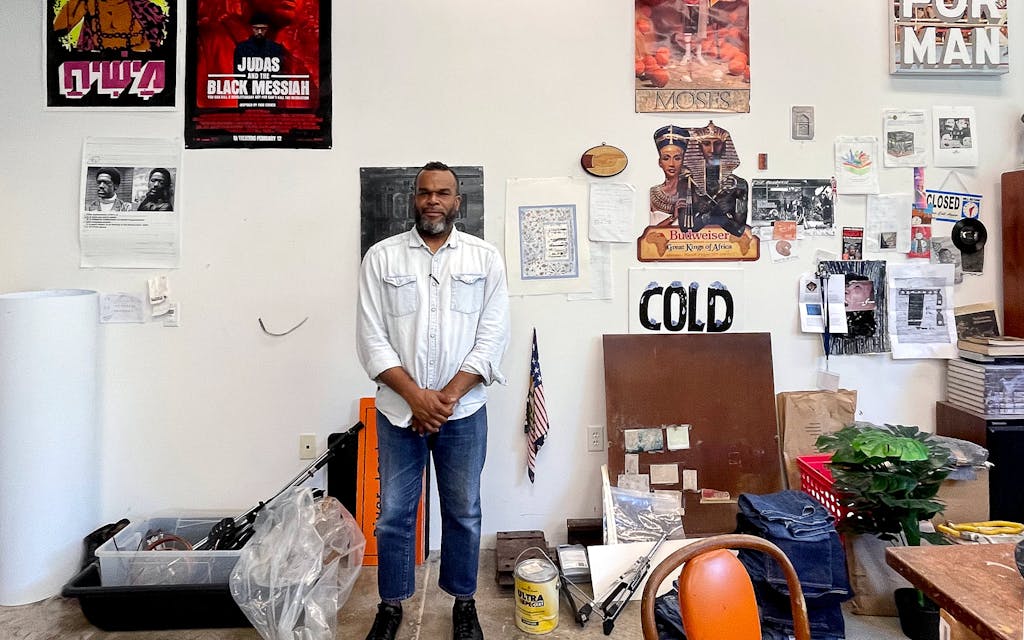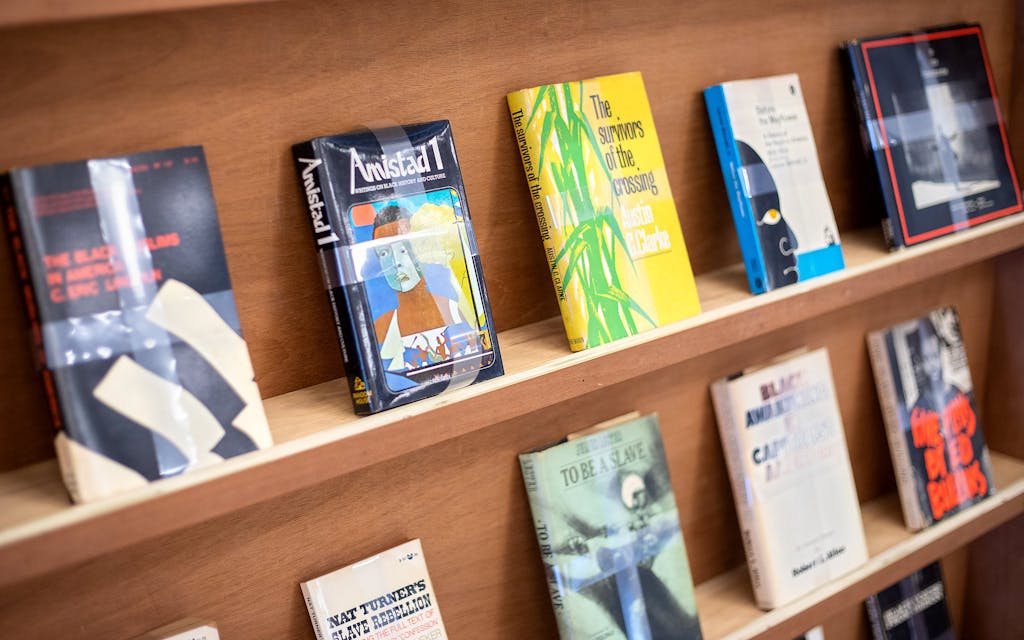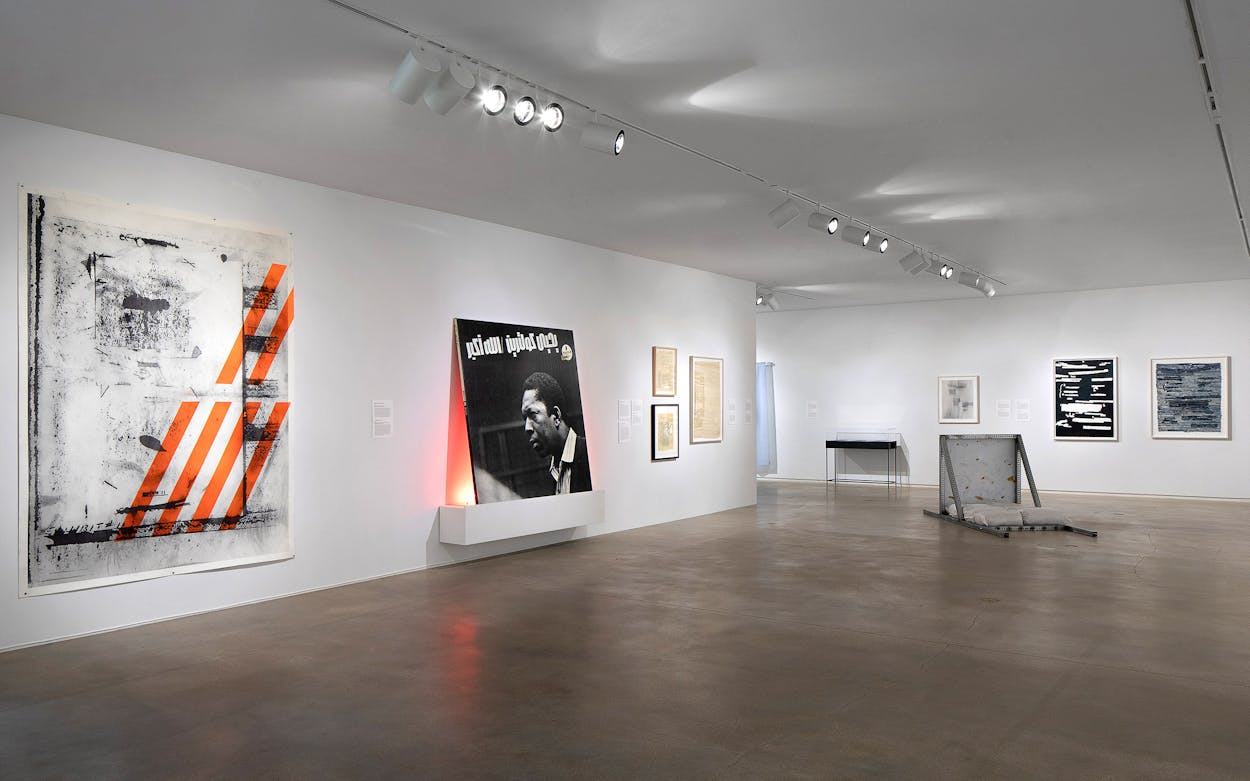Let’s start with The End of My Beginning.
Jamal Cyrus’s tabletop sculpture depicts a miniature, classic American home that’s enveloped in a sea of tufted black hair. The hair spills over the roof and around the white structure, nearly burying the front door and several tiny figures in an island of Afro moss before stopping abruptly at an invisible intersection on an invisible street.
Without reading the label, a viewer might assume the piece sprang from last summer’s wave of Black Lives Matter protests. The sculpture is about Black revolution, and its power has intensified in the past year. But it was made in 2005, as Cyrus began to focus his art on earlier flash points of American social and political consciousness—the era of the civil rights movement and the Black Panther party, not long before he was born in 1973.
The End of My Beginning is now the title piece of Cyrus’s survey at the University of Houston’s Blaffer Art Museum. This is Cyrus’s first museum survey exhibition, and he also curated a companion show at Texas Southern University, “Levels & Layers: An Artist’s Reflections on Third Ward.” Both are on view through September 19. Cyrus, who turns 48 on July 23, has earned this moment the hard way, quietly honing his vision for more than two decades. The survey covers a sixteen-year span that started a year after he earned his undergraduate degree at the University of Houston. This is not the work of an emerging artist or just a polite nod to a local name. In ideas and execution, the more than fifty quietly provocative objects, images, and installations on view are fully baked and mature.
Cyrus’s work probes the histories of Black artistic expression (especially music), political suppression, and protest. He’s really been on fire the past three years. Winning Art Basel’s BMW Art Journey prize in 2017 enabled him to extend his research across four continents. He always wants to know more—and he wants you to want to know more, too. Because of that, his art sometimes conceals as much as it reveals, just enigmatic enough not to preach. Every mysterious element means something.

What’s obvious is his virtuosity with transforming simple but culturally loaded materials into metaphoric poetry. Found objects, papyrus, Jet magazines, vintage posters and albums, dried sargassum, grits, denim, leather, drums, and saxophones all get this treatment. They often appear in distinctive bodies of work, evidence of an artist who thoroughly chews his food for thought. For example, Cyrus draws the compositional motif for his Cultr-Ops series from the redacted documents of an infamous FBI program that disrupted Black organizations for 25 years. The marked-up documents reminded him of black-and-white Franz Kline paintings, “abstract but full of emotional baggage,” he says. “Cultr-Ops in Blue” (a tapestry of torn denim) and “Cultr-Ops in Wax” (an even larger wax crayon drawing) interpret the same document, from the Bureau’s file on Malcolm X, as if it might be a score for an abstract musical performance by John Cage. Even when works are not part of a series, there’s continuity. Cyrus uses sargassum, for instance, as a shorthand for referencing Black bodies (it looks like Black hair when it’s dry) and the African diaspora (because ships carrying enslaved people crossed the Sargasso Sea).
One of the show’s big attention-getters is ILUVTHALORD,HEHERDMYCRY, a new, site-specific mural collaboration with veteran Third Ward sign painter Walter Stanciell. Its blue and green text fills the museum’s front wall like a shout of gratitude. But it’s more complex than that. The text spells out the opening lyric of a hymn based on Psalm 116. An English Christian composer converted it to a song in the eighteenth century, and the dynamics changed when the hymn became popular in Black churches. The words are stretched to emulate the sound of an ecstatic, transcendental worship performance—the kind of spirituality that bolstered civil-rights protesters in the twentieth century.
Although Cyrus converted to Islam before he was twenty, this kind of music is in his bones. He was three when his uncle, the Houston-based composer and songwriter V. Michael McKay, launched a musical ministry that made his family gospel royalty. His mother sang in McKay’s group. Cyrus grew up in Houston’s Hiram Clarke neighborhood, and when he went to the city’s High School for the Performing and Visual Arts, his ears opened wider. He began to see music as a way to understand himself.


Like many of his generation, he was deep into hip-hop, but the commercialization of the culture bothered him. Cyrus started collecting vintage vinyl albums as an undergrad, when he was focused on doing black and white photography and learning digital media skills. He began photoshopping covers and labels—akin to remixing or sampling the imagery—to imagine more politically potent songs. That work eventually morphed into his Pride Record series.
Pride Record findings—Tokyo, one of three Pride installations in the museum’s lobby, mimics a sale rack, but the covers of the CDs it holds are semi-fictional. While an actual Pride label had a catalog of popular funk, R&B, and psychedelic rock in the early 1970s, Cyrus conjures a company with a civil-rights agenda that was curtailed by the FBI. Although the wall text explains that his “musical artists” were real-life activists, the ruse is thorough. Post-it notes on the CD covers make you think Cyrus unearthed them at some dusty shop in Tokyo.
Elsewhere in the show, he digs further back into the history of Black music. With 2018’s MSY, Cyrus challenges viewers to think about why a bronze conch shell, an earthenware vessel, and the twisted ball of a plant root might be lined up together in the same display case. The wall text explains that the items are early forms of trumpets symbolizing the Middle Passage, West Africa, and the American South. Nor is the title arbitrary. MSY is the code for Louis Armstrong New Orleans International Airport, evoking the birthplace of jazz.
Trumpets are also central to Conga Bomba & I.E.D., a sculpture that shines with warlike intent: it consists of three weapons fashioned from deconstructed brass instruments. Nearby is a well-preserved saxophone from Texas Fried Tenor, a performance piece Cyrus has done just a few times. Before a live audience, he breads an instrument as if it’s a massive chicken wing and deep-fries it, amplifying the gurgling of the hot oil and mixing in other sounds. It’s a cool stunt, but also a meditative, ritual ode to the soulful legacy of the state’s legendary tenor-sax players and Cyrus’s family’s great cooks. (To close out the exhibit, Cyrus will perform Texas Fried Tenor at the Blaffer on September 18 with percussionist and composer Jamire Williams.)
At TSU, “Levels & Layers: An Artist’s Reflections on Third Ward” is an insightful and elegant homage to Cyrus’s artistic birthplace. This show glimpses how the neighborhood’s visual traditions developed from the late 1950s through the present, acknowledging the teachings of proto-Afro-futurist John Biggers; the social practices of Rick Lowe’s Project Row Houses; and self-taught artists ranging from sign painters to the ceramicist Earnest Snell. Cyrus has put just one of his own works in the mix, a smallish collaborative painting with stretched text (like the Blaffer mural) that reads “Steel Away.” In a central space, visitors can can post photos from the community and peruse books.

University Museum director Alvia Wardlaw, one of Cyrus’s early mentors, can still picture Cyrus, Robert Pruitt, Dawolu Jabari Anderson, and Kenya Evans conceiving their famous art collective, Otabenga Jones & Associates, in the art department lounge. (Cyrus spent a few years at TSU before graduating from UH.) The OJA name was inspired by the appalling story of Ota Benga, an abducted Congolese man who was briefly exhibited with monkeys at the Bronx Zoo in the early twentieth century and eventually killed himself. The artists told everyone Otabenga Jones was their teacher and the collective’s founder. The story persisted when their work went to the Whitney Biennial in 2006. It was a tongue-in-cheek way “to mess wit’ whitey,” a goal listed in the collective’s mission statement.
That kind of mischief aside, Cyrus was a quiet, inquisitive student who always had questions and wanted to know more after classes, Wardlaw says. “That has remained with him.”
Planning a wall graphic visitors see as they enter “Levels & Layers,” he picked Wardlaw’s brain after he heard about the Black page in Houston’s Forward Times, a 61-year-old community newspaper she knew well. The Black page presented crime news from a community perspective, with the recurring headline, “It was like this.” The printing was reversed: white text on a black background, so it smudged readers’ fingers. “They would publish pictures of men who had been beaten by the police,” Wardlaw says. “You turned to that because you wanted to know the truth.”
To create the graphic, artist Phillip Pyle II wrote what looks like a Black page clipping, only with joyful news, detailing how a drum major from TSU’s Ocean of Soul marching band gathered generations of area artists into an ecstatic parade. The story ends on an endearing high note: “Not a normal day in Third Ward but not that unusual either.” It’s a subtle reminder that the community’s cultural foundations are deep. (Cue a chorus of homegrown musical legends as diverse as Lightnin’ Hopkins, Beyoncé and Fat Tony.)
Cyrus has the distinguished, patient demeanor of a professor who is also a perpetual learner. “My work has always been about educating myself,” he says.
I get that. But I wanted to know why the name of his survey refers to such an old work. Didn’t his “beginning” as an artist end years ago? “Yeah, unless it’s kind of a long, drawn-out beginning—which, maybe!” he says, laughing.
Turns out it’s the words, not the sculpture, that feel appropriate to him now. Aside from the upheavals of the COVID-19 pandemic, Cyrus went through a divorce in June 2020, lost his father this past March, and in April married the New York City–based artist Leslie Hewitt, a recent Guggenheim fellow who teaches at Cooper Union. This summer he left another nest—his teaching gig at TSU—to give himself two years to focus on his art and research, “hopefully to take it to another place,” he says. “Jazz musicians call it wood shedding.”
He’s certainly not on pause. Two denim tapestries in progress cover the floor of his Midtown Houston studio. They’ll be six by nine feet, his largest works yet in that series. They’re headed for this fall’s Prospect New Orleans triennial, along with a sculpture that incorporates sound by Jamire Williams.
Houston art dealer Kerry Inman has championed Cyrus’s work since 2014, and his profile has risen steadily since then. The Art Journey prize fueled him with a lifetime of inspiration. Last year, Cyrus won another major award, the High Museum of Art’s David C. Driskell Prize, for his contributions to African American art.
When Blaffer director Steven Matijcio moved to Houston from Cincinnati in early 2019, giving Cyrus a show was a priority. He had seen Cyrus’s work circulate nationally and watched the accolades pile up. He couldn’t believe no institution had yet given one of the state’s most talented native sons a survey with a catalog, to solidify the artist’s place in the historical canon. “It was almost too good to be true,” Matijcio says.
“Jamal has this perspective and insight that are obviously important at home in Texas, but winning the Driskell confirms how important and provocative that voice is across the country,” he adds. “This is a career that just continues to grow.”






